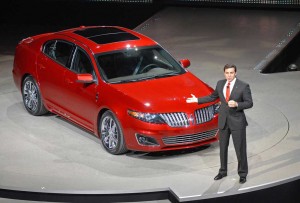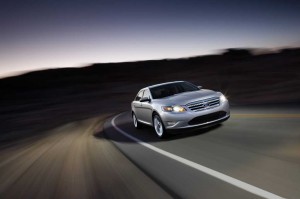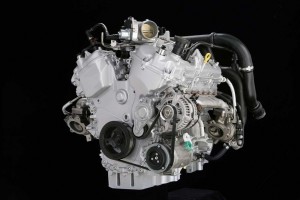
Ford President Mark Fields reveals the 2010 Lincoln MKS with Ecoboost. TheDetroitBureau.com tests the new engine, which Ford bills as a high-mileage, cost-effective alternative to diesels and hybrids.
It has become something of a given, these days, that the hybrid-electric vehicle is the only viable way to deliver significant improvements in fuel economy, at least in the U.S. market. While diesels dominate in Europe, Americans have largely ignored the tremendous mileage benefits offered by “oil burners.”
But there could be a third option, at least if Ford’s ongoing claims for its so-called Ecoboost engine lives up to its hype. The new powertrain liberally powers from the technology that has made the modern diesel so effective, but it uses conventional gasoline.
If all goes according to plan, variants of the Ecoboost could be offered in 90% of Ford products by the middle of the next decade. In V6 form, it will power the revival of the legendary Taurus SHO, as well as a version of both the Flex “people mover” and F-150 pickup. And while Ford officials continue to play coy, they have all but confirmed that an inline-4 version of the Ecoboost will appear in such products as the next-generation Focus, and perhaps even the eagerly-awaited Fiesta subcompact.
 Another model that could desperately use the technology – originally shown in concept form as the TwinForce engine – is the Lincoln MKS. While the sedan has received numerous kudos since its recent launch, critics have faulted the lack of a V8 in a segment that expects a more performance-oriented option. A 355-horsepower version of the Ecoboost, which should yield something around 17 mpg City, 25 Highway, or 20% above a comparable V8, could surmount the skeptics’ concerns.
Another model that could desperately use the technology – originally shown in concept form as the TwinForce engine – is the Lincoln MKS. While the sedan has received numerous kudos since its recent launch, critics have faulted the lack of a V8 in a segment that expects a more performance-oriented option. A 355-horsepower version of the Ecoboost, which should yield something around 17 mpg City, 25 Highway, or 20% above a comparable V8, could surmount the skeptics’ concerns.

Ford plans to introduce Ecoboost in a number of products, including the Lincoln MKS, the Ford Flex and, shown here, the revived Ford Taurus SHO.
“We now can deliver V- power without sacrificing fuel economy,” contends Ford’s senior engineer, Pete Reyes.
The automaker recently invited TheDetroitBureau.com to test drive a prototype of the 2010 Lincoln MKS equipped with EcoBoost, and the initial results were impressive. On paper, the V6 delivers an uncannily flat torque curve. In practice, that proves entirely accurate.
Initial idle quality was on a par with a bigger V-, smooth and acceptably quiet. Launch feel was also in line with a V8 boasting similar output. Our Lincoln shot off the line and got to 60 a lot faster than we had anticipated, as we headed into the sweeping left-hand corner of the high-speed oval at Ford’s Dearborn (Michigan) test track. We let the speedometer settle back to 50 to try out a series of passing maneuvers and, yet again, found the engine responsive and rewarding. At no time did we experience any turbo lag, that frustrating hesitation often suffered with turbocharged engines as they begin to spin up to speed.
We’ve seldom found a Detroit V6 that matched the manners of an 8-banger, indeed, even the better import V or I-s. Domestic entries have, with rare exception, been rougher, and noisier. The Mustang V6 is an unfortunate example, with truck-like manners and a tendency to rasp like a winded runner under wide-open throttle. With Ecoboost, Ford engineers have done a good job of tuning the engine. It is surprisingly quiet until you slam the accelerator, but then it delivers the sort of deep-throated rumble that you most often associate with a domestic V8. That’s a real confidence-builder that makes you feel like you’re getting the level of performance you’d expect from a luxury car like the MKS.
We need to stress that we had only a brief opportunity to drive the MKS with Ecoboost, as well as several other models that we have agreed not to discuss in detail. We will disclose that Ford engineers have been spending a lot of time working out the bugs on the technology, which requires tremendous tuning for each model to get it right. A less advanced prototype of another Ecoboost-powered vehicle underscored that challenge, exhibiting some decidedly unpleasant behaviors that we’re promised will be fixed before the launch of that model’s production.

Ford's Ecoboost V6 relies on a pair of small turbos -- which reduces turbo lag -- and a high-pressure fuel pump. Fuel is injected directly into the cylinders, improving burn and reducing knock. The automaker projects better performance as well as a 20% increase in fuel economy.
A quick Ecoboost primer will underscore the complexity engineers are facing. The beating heart of the engine – or hearts, if you prefer – is a pair of small turbochargers. Size matters, as a key goal of Ecoboost is avoiding the dreaded turbo lag, which is caused when larger turbos slowly “spool up” to speed. Turbos force air into an engine to boost power. By using an intercooler, to chill the charge of air, Ecoboost breathes even deeper.
The engine uses a diesel-like, high-pressure pump. Though it operates nowhere near the pressures of a diesel, it’s still able to move fuel quicker than a conventional pump, at 2,175 psi, or about 35 times the pressure of a conventional V-6. In turn, fuel is sprayed directly into the combustion chamber through six individual jets. That delivers several additional benefits, including a better air/fuel mix.
“Another benefit of our direct-injection method is that it cools the air right where you’re going to burn it,” according to Ecoboost design manager Brett Hinds. “This action both improves the breathing of the engine and minimizes knocking.”
Ford officials aren’t yet revealing the price of their new Ecoboost technology, but they’ve been boasting that it has a real cost advantage over hybrids and diesels, and one that could yield a payback – saving as much in fuel as you the premium you pay for the technology – in just two years. That would suggest perhaps $1000 or so more than a comparable V6. Ford faces a tough challenge here, the hardware is expensive, but it hasn’t been able to command premium pricing in the market.
We’ll have to wait a few months until we see the first Ecoboost hit production, but if it drives as well as the prototype we tested – and yields the fuel economy savings Ford projects – it could proves a significant advantage for the U.S. maker and a threat to those competitors who need to use more costly technologies, like diesels and hybrids, to get similar fuel economy improvements.
